During the first half of the 18th century in Portugal, religion set the limits for nearly all aspects of social life. A multitude of churches dotted the city. Time was measured by tolling bells and the succession of religious festivals. One of the largest public festivities was the procession during the Feast of Corpus Christi, with all of the city’s clergy, professional organisations, and charitable groups participating. In addition to religious symbols, the city overflowed with banners, groups of musicians and dancers, and a great number of wooden structures representing mythological figures. All Saints’ Day celebrations were another memorable moment, mixing older traditions—such as visiting cemeteries and offering flowers—with the Christian belief in an afterlife.
We need to understand that Catholic masses and the Holy Communion celebrated in the 18th century differed from today. The congregates did not play any major role. From a liturgical point of view, the priest was the centre of focus. He represented the people and established a singular connection to God, so to speak. He conducted mass with his back to the assembly, facing the altar, and talking to God on behalf of his congregates rather than creating a unity with them. And this explains why churches, especially churches within monasteries, multiplied over time. Different churches celebrated the same liturgical mass without taking the trouble to reunite all the parishioners in one place.
As with other aspects of life in the 18th century, mass was much less standardised than today. Of course, the Roman Missels dictated the order of the texts and rubrics at mass, but there was also considerable room for personal worship and even small rites depending on the style and spirituality of each priest. In 1726, Rome printed a newer version of the Roman Pontifical (Roman Catholic liturgical instructions) in an attempt to standardise rites. Nevertheless, the traditions and spiritual devotion within each congregation continued to exert major influence over church life throughout the 18th century.
Mass followed the original Latin from the first centuries, and the historic influence of each part of the celebration remained significant. First came the Introit, the impressive entrance inspired by processions at the Vatican. The preparation followed when the priest whispered prayers in Latin.
The priest then put on his vestments next to the altar, a symbol of assuming a new sense of purity. The prayers at the foot of the altar, kneeling, and the kissing of the altar featured the stone representing Christ’s own tomb according to the interpretations given by the early Church Fathers. Next came the censing of the altar, crucifix, and relics—especially those of martyrs. The devotion to saints as examples of spiritual history and faith had continued to expand throughout the 16th and 17th centuries. The various mass proceedings continued as such, culminating in the transubstantiation—the mysterious moment when bread and wine become the body and blood of Christ, as stated by earlier theologians, creating the spiritual union with Jesus and between believers who gathered together to worship Him.
The Missel served as a script of actions and rites, including different texts recited by the priest and suggestions of Gregorian chants, which left a wide window open for individual worship. The public’s great attraction to spiritual fantasy made 18th-century mass a theatrical event. Religion—what historians have described as a programme of domination and discipline of the people—was also a tale about suffering and death and an answer to the ambiguities of fate, making use of natural elements such as wheat, grapes, and bread or mythological symbols such as lambs, blood spilt by martyred heroes, and the infinite fortune of motherhood, with which young girls could identify.
Every celebration basked in a décor of colours, light, and sound. Plaster statues or spectacular, temporary structures made of wood and fine fabrics required specialised training for the interior decoration of churches, resulting in craftspeople being responsible for all of the cushions, drapes, and elements made from fabric and trimmings. Likewise, small orchestras formed in various churches throughout Lisbon, following the example of the baroque church built near the palace by John V of Portugal, where the celebrations with its famous choirs and instrumentalists were strongly influenced by Italian music. The vestments and all the liturgical objects were also produced from a very artistic standpoint. To that end, mass was an extremely important meeting point—a place to reinforce social ties and spread ideas, especially due to women gathering. Indeed, women favoured the very popular masses and sermons as means to escape the solitude they endured—particularly middle-class wives married to lawyers, merchants, and doctors. They shared their opinions on day-to-day life, criticised customs, and reflected on their circumstances, as various pamphlets published throughout the 18th century show.
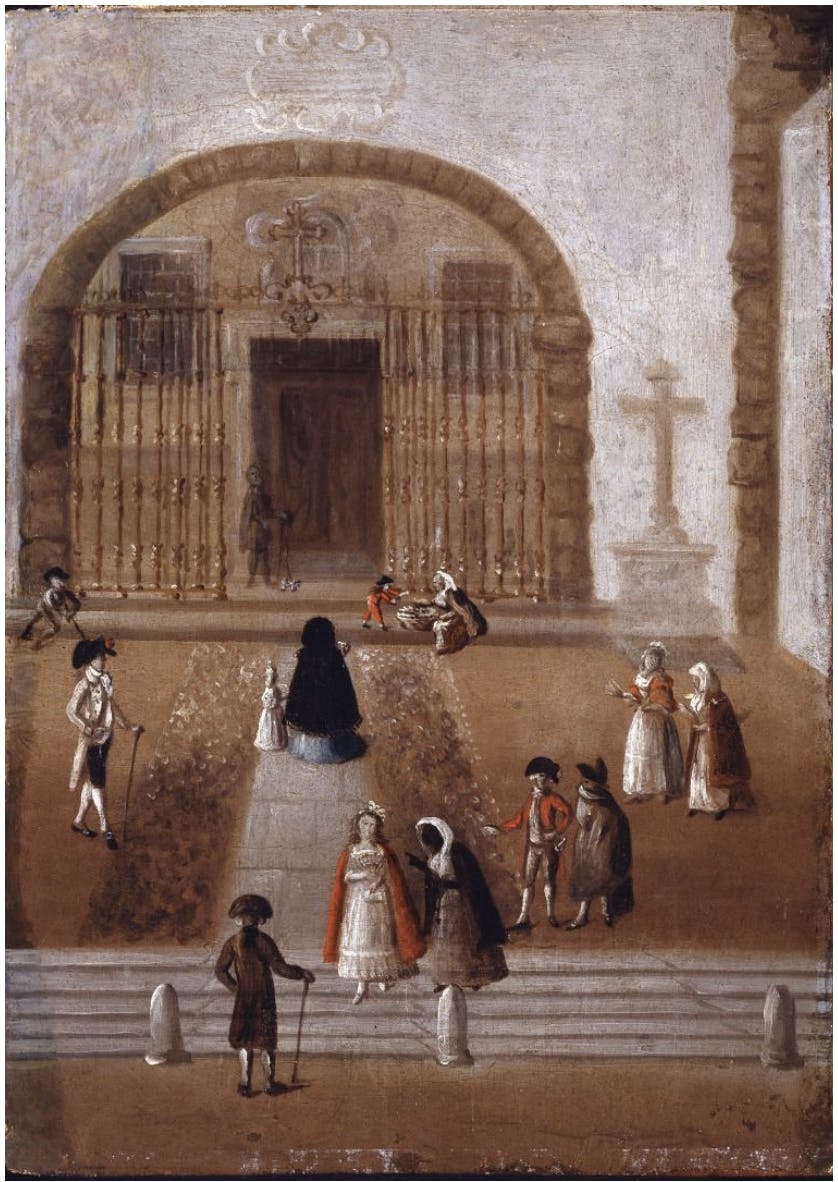
At the Church Door, painting by an unknown artist, second half of the 18th century , Ricardo do Espírito Santo Silva Foundation, Lisbon.
The church square was the meeting place where vital news or notices were posted. At the foot of the gate, a woman asks for alms, perhaps selling sweets or rolls. The costumes are neat, especially the women's mantillas and the men's silk stockings. We also see an enslaved woman accompanying her mistress. The men and women do not communicate and seem to move around, keeping a wide berth between each other.
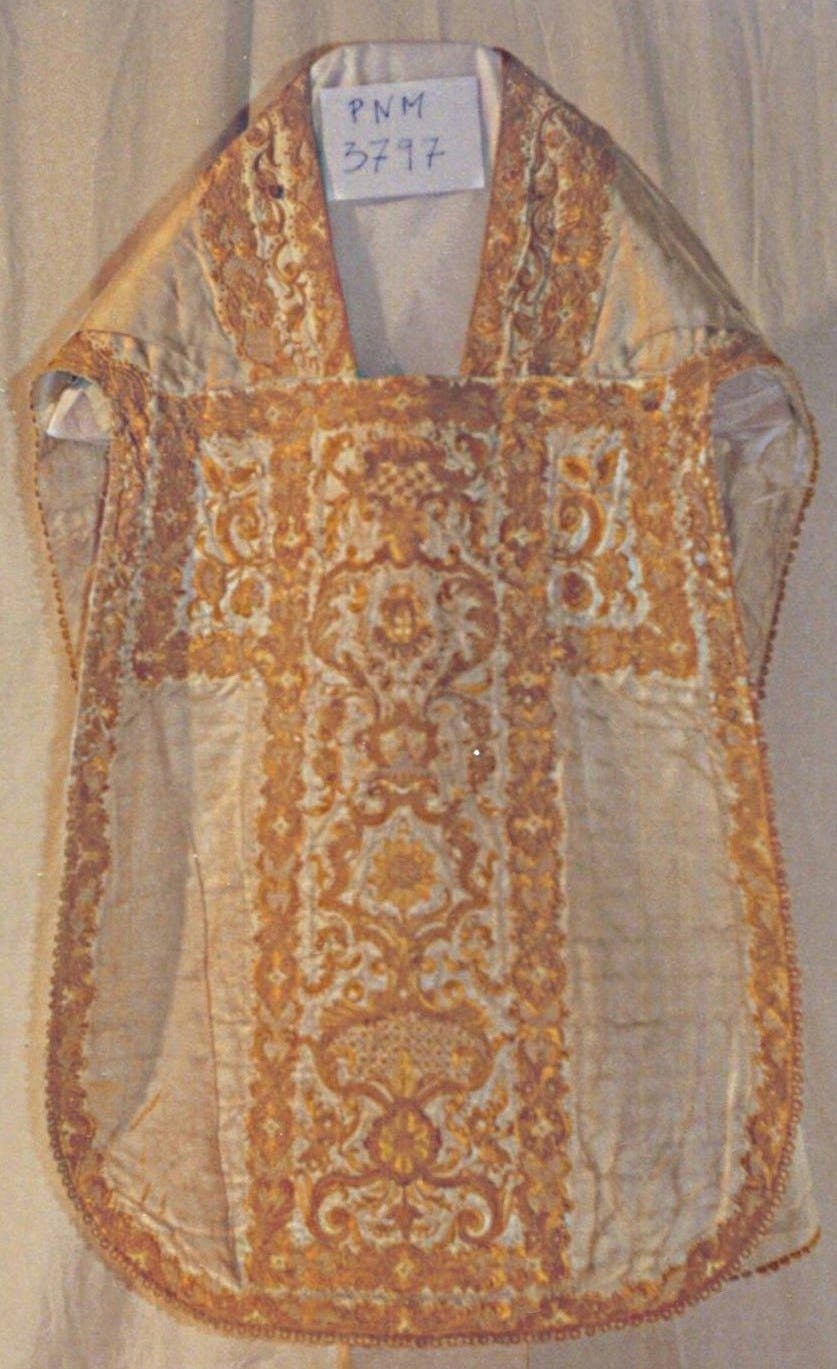
Roman chasuble of satin, embroidered in gold, ornamented with a cross - made in Genoa. The Chasuble was the garment worn by the priest, over the alb (white tunic) and the stole (worn around the neck, falling on the chest). Of Roman origin, it had the meaning of the priestly robe, such as the ancient Jews wore, when immolating the paschal lambs, according to the Law of Moses. Thus, Catholic ecclesiastics were to wear the Chasuble during Mass. White was the colour used on holy days, such as All Saints' Day. (Note the priest's vestments - pictured in the centre: http://www.museudearteantiga.pt/exposicoes/anatomia-de-uma-pintura)
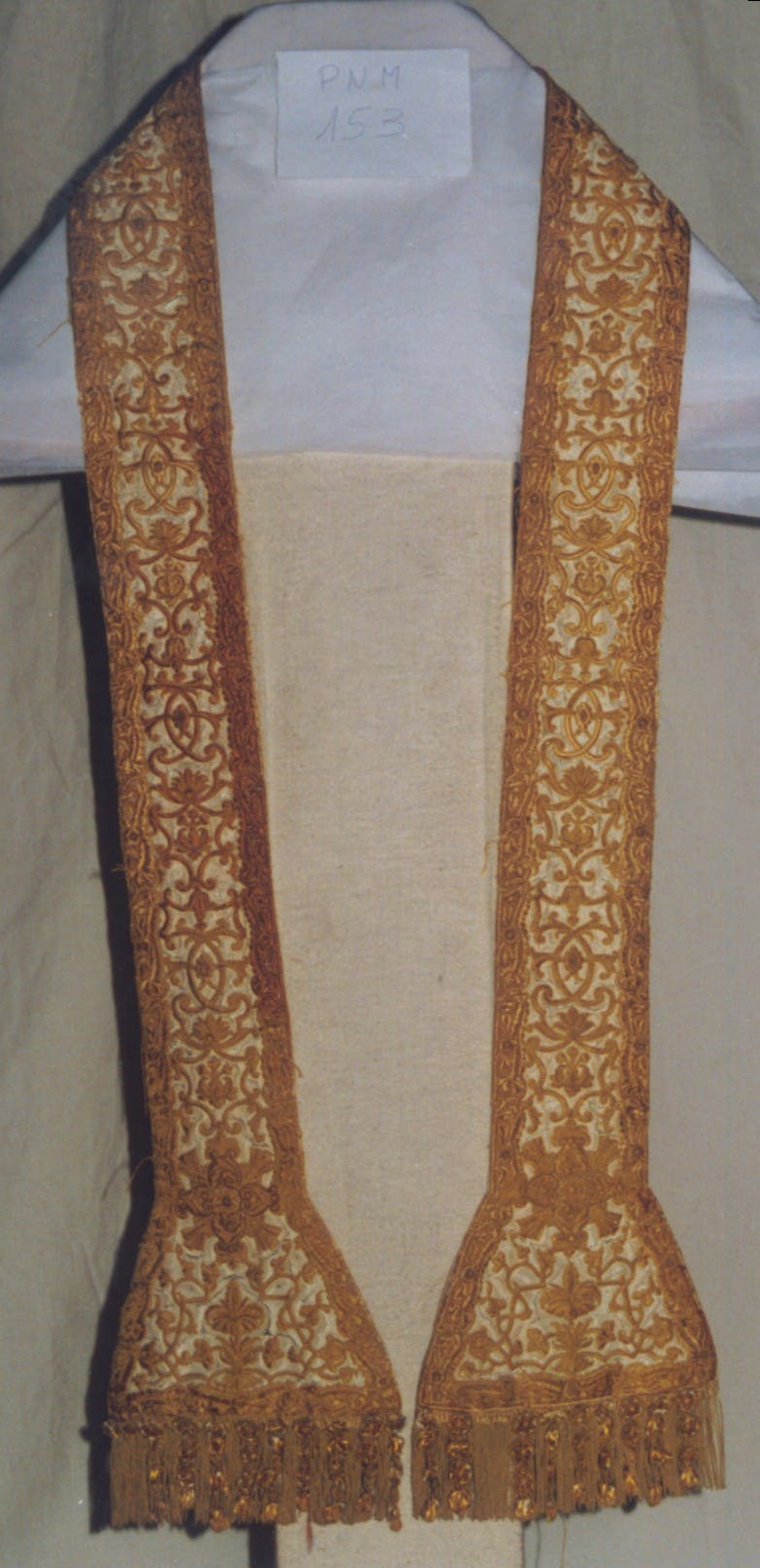
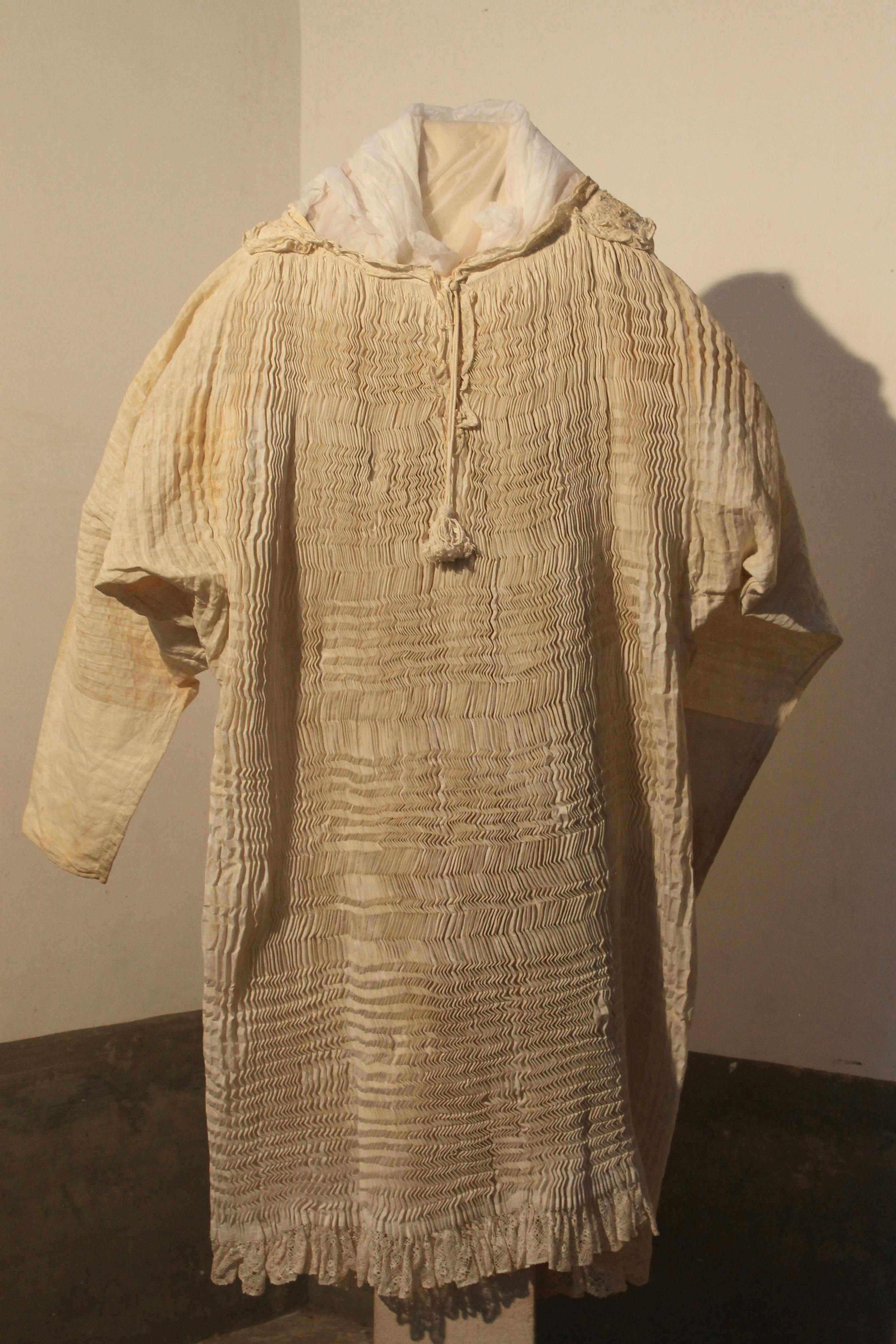
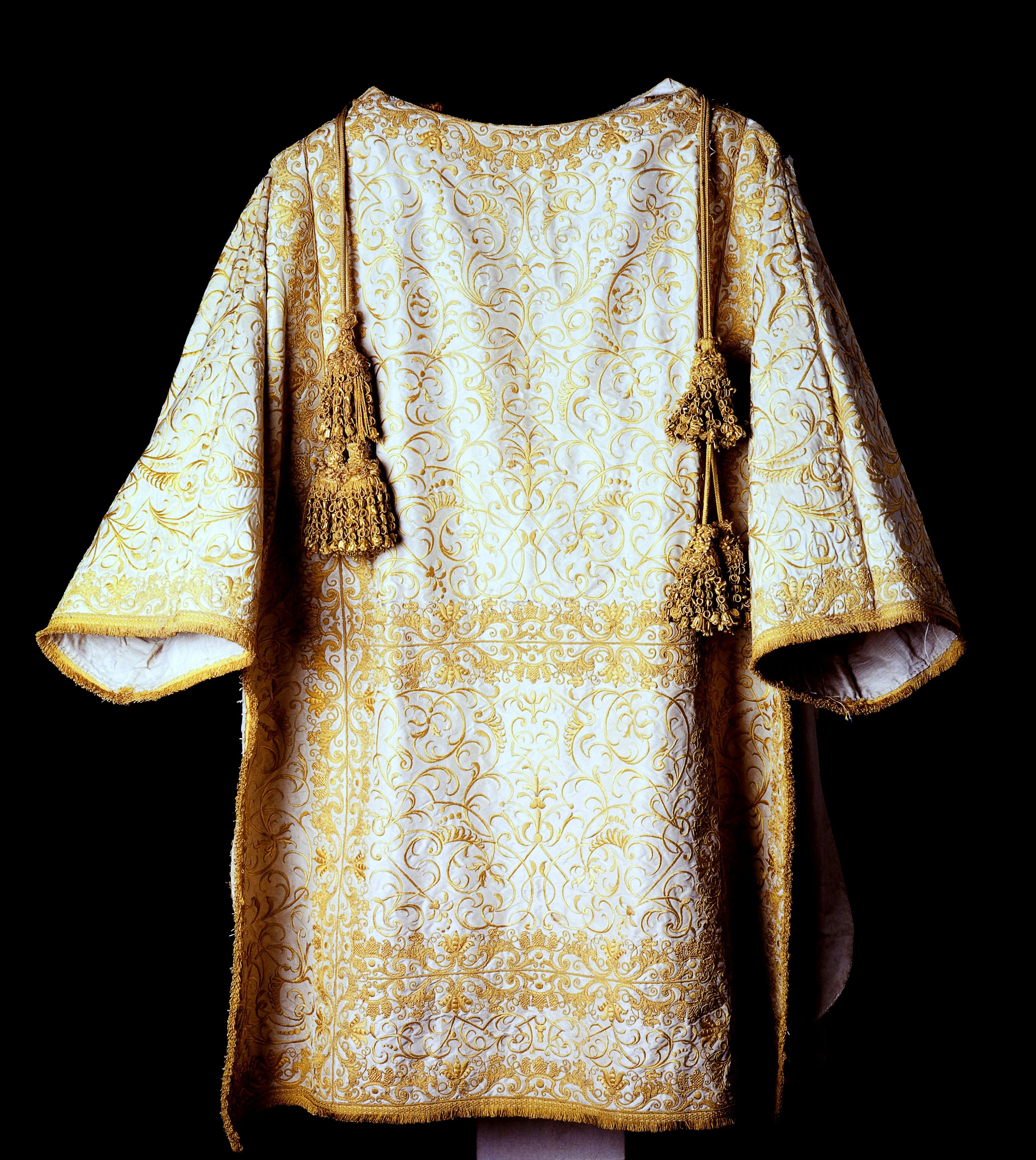
Dalmatic richly embroidered with geometric and floral motifs. Garment worn by deacons, based on ancient Roman luxury clothes.
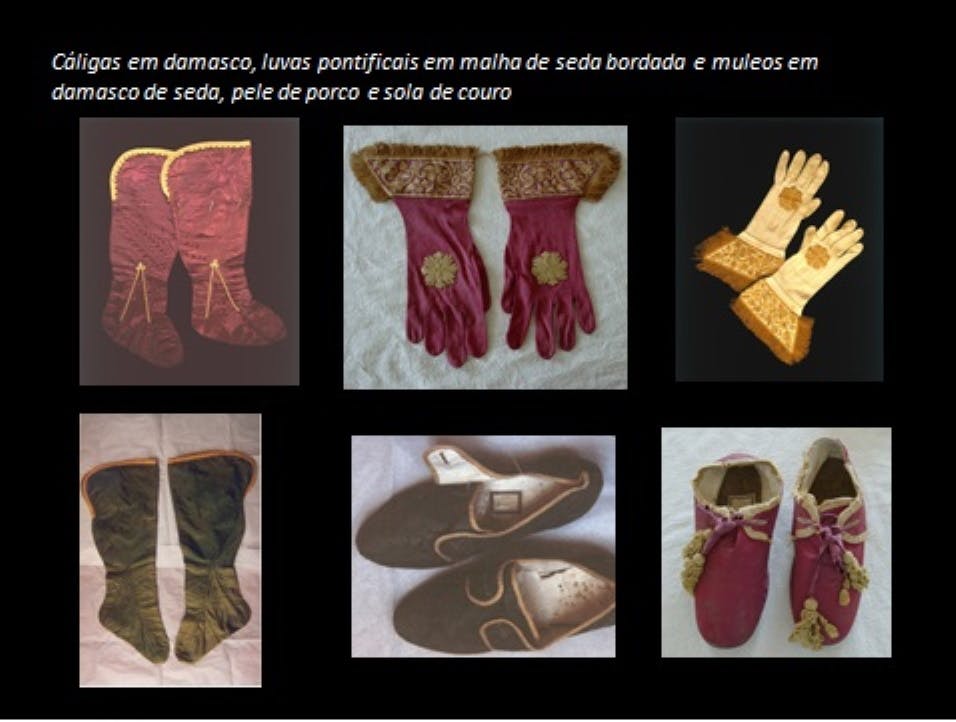
Caligas (stockings) in damask, pontifical gloves in embroidered silk mesh and muleos (shoes) in silk damask, pigskin and leather sole.
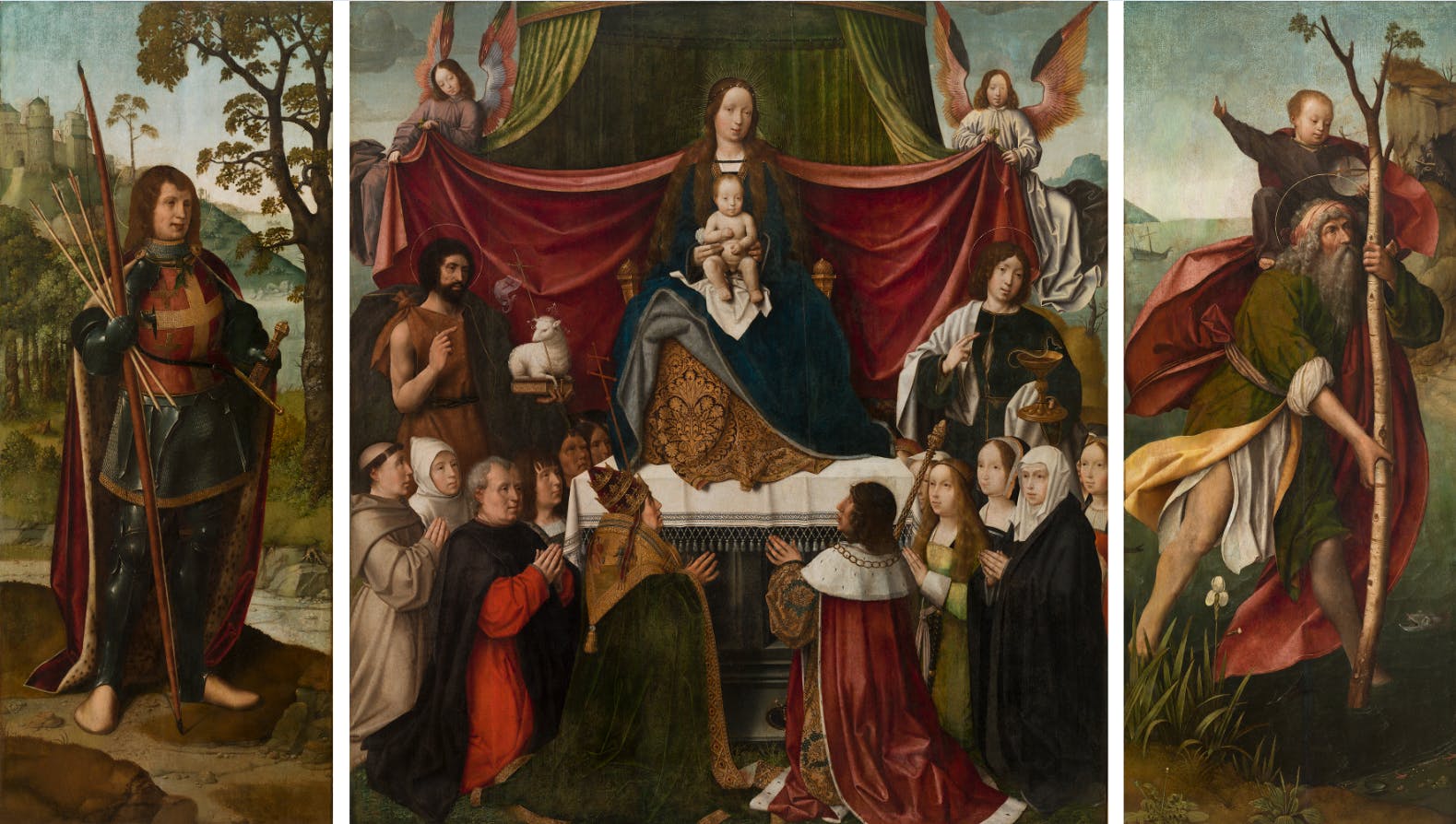
Painting from 1511-1515, commissioned by a couple of merchants from Madeira who made their fortune in the sugar trade to a painter from Bruges, Jan Provoost. Intended for a small chapel facing the sea, this painting is similar to many paintings commissioned for churches in Lisbon, but which disappeared in the 1755 earthquake. Virgin Mary with Baby Jesus is in the centre, representing Mercy. We also recognise Saint John the Evangelist and three martyrs: Saint Sebastian, Saint John the Baptist, and Saint Christopher—patron saint of travellers, with ties to the East having converted populations in Central Asia.
- Why this painting?
The Quake church was inspired by various churches in Portugal, Spain and Brazil, and, with some artistic freedom, it attempts to recreate the church of Nossa Senhora da Misericórdia de Lisboa, a church that in 1755 occupied the place where the church of Nossa Senhora da Conceição Velha is today, on Rua da Alfândega, in Lisbon. On its façade, one of the best Manueline structures that survived the great earthquake, you can still see a sculpture that represents Nossa Senhora da Misericórdia, with her characteristic mantle. That is why we chose this wonderful triptych for the decoration of the church's interior, which can be admired in the Museu Nacional de Arte Antiga, in Lisbon.
Bibliography
Gonçalo de Carvalho AMARO,UmaIgreja, DuasHistórias: umpercursopelahistória e pelopatrimónio da antigaigrejamanuelina da Misericórdia de Lisboa, SCML, 2015.
Ana Cristina ARAÚJO, A MorteemLisboa: Atitudes e Representações 1700-1830, Livros Horizonte, 1997.
Rui BEBIANO, D. João V. Poder e Espectáculo, LivrariaEstante, 1987.
P.e Antônio COELHO, Curso de Liturgia Romana, Braga, 5 vols, 1926- 1930.
ConstituiçõesSynodaes do Arcebispado de Lisboa (…) Accrescentadasnestasegundaimpressao com hum copiosoRepertorio, Officina de Filippe de Sousa Villela, Lisboa, 1737.
Antônio Camões GOUVEIA, «As artes e o sagrado»,História Religiosa de Portugal, (Dir. Carlos Moreira AZEVEDO), Vol. II, Humanismos e Reforma, Círculo de Leitores, 2000, pp. 462- 486.
Josef A. JUNGMANN, The Mass of the Roman Rite: Its Origins and Development, Bezinger, 1951.
Ernest H. KANTOROWICZ, The King's Tivo Bodies: A Study in Medieval Political Theology, Princeton University Press, 1957.
JoâoCampelo MACEDO, Thezouro de Ceremonias que conte/n as das MissasRczadas. e Solemnes, ass'un de Festas, co/no de Defuntos. E tamhem as da Semana Santa. Ouarlufeira dc Cinza. das Candeyas. Ramos. e Missas de Natal [1657], Ediçãorevista e aumentadaporCônego João Duarte dos SANTOS, Oficiana de Francisco Duarte da Matta, Braga, 1734.
CátiaTeles e MARQUES, Nos bastidores da liturgiatridentina O Mobiliário Monumental e as Sacristiasem Portugal doséculo XVI ao XVIII, Dissertacâo de Mestradoem Historia da Arte, Universidade Nova de Lisboa, 2007
Federico PALOMO, A Contra-Reformaem Portugal 1540-1700, Livros Horizonte, 2006
Antonio Filipe PIMENTEL, Arquitectura e Poder: O real edifício de Mafra, Coimbra, 1992.
João Baptista REYCEND, O Sacrosanto, e EcuménicoConcilio de Trento emLatim e emPortuguez,tomo I e II, OficinaPatriarcal, Lisboa, 1781.
Fr. Mathias de SANTA ANNA, CeremoniaiEcclesiastico. segundo o ritoromano, para o uso dos ReligiososEremitasDescalcos da Ordem de Santo Agostinlio da ReaiCongregacão de Portugal, e para osmaisecciesiasticos que seguemosmesmoRito Romano. distribuidoemcincotratados de coro, e Altar, e de algumasacçoensparticulares da mesmaOrdem, Oficina de Miguel Manescal da Costa, Lisboa, 1743.